Coronavirus (COVID-19) volunteering - third sector perspectives: survey report
Findings from a survey undertaken to gather insights into the experiences of Scottish third sector organisations and other stakeholders involved in supporting volunteering during the pandemic.
3 The volunteer response during the pandemic
3.1 How volunteering changed during the pandemic
The outset of the pandemic saw a huge upswell in people wishing to volunteer to help others. The exceptional and unprecendented nature of the crisis was without doubt a factor in motivating many people to offer to volunteer. This was evident both from the response to the Scotland Cares campaign, which generated over 60,000 volunteer sign-ups, and from the rapid creation of hundreds of community-based 'mutual aid' support groups across Scotland.
The picture of what actually happened with volunteering through the course of the pandemic is complex and dynamic, however, with important changes taking place in response to the changing policy environment and the changing COVID-19 restrictions. As a result, there is no single pattern that describes how volunteering changed during the pandemic. The patterns of volunteering were hugely variable depending on the sectors involved, with many organisations having to reduce pre-existing formal volunteering opportunities, while at the same time informal volunteering and mutual aid-type organisations were expanding.
We asked the survey respondents to tell us about how volunteering changed during the pandemic and about the numbers of people undertaking different types of volunteering – formal, informal and mutual aid – during the different phases of the pandemic. We also asked respondents to reflect on other important changes, such as changes in who was volunteering, whether there were any changes in volunteering in areas of higher deprivation, and what volunteering tasks were important at different stages in the pandemic.
3.1.1 Volunteer-involving organisation views on changes in volunteer numbers
The majority of the volunteer-involving organisations responding to the survey were organisations with volunteer programmes in place prior to the outset of the pandemic. When the first lockdown began, many organisations had to suspend face-to-face work with service users, staff and volunteers. Although volunteering was allowed as an exception to the stay-at-home requirements, volunteers who were older or who had health conditions making them vulnerable to COVID-19 were advised to remain at home, and many withdrew from face-to-face volunteering. The complete cessation of non-essential trading, in-person events and fundraising activities and face-to-face programmes along with the closure of many premises meant that many formal volunteering opportunities that were not directly related to the COVID-19 response simply stopped, at least initially.
'Our retail volunteering operation was paused during the lockdowns due to the retail estate being closed. Some of our volunteers did go to other, more local organisations to volunteer at this time, such as vaccination centres, food banks etc.'
'Most of the events and activities we organise rely on the community building that we manage, and its kitchen. [Community hall] had to be closed in March 2020 and, given current restrictions, we don't expect to be able to reopen or start any meaningful group activities before Autumn 2021.'
'Our monthly children's clubs stopped during lockdown. The leisure centre where we meet was closed. Some volunteers were shielding and did not return when we reopened after lockdown.'
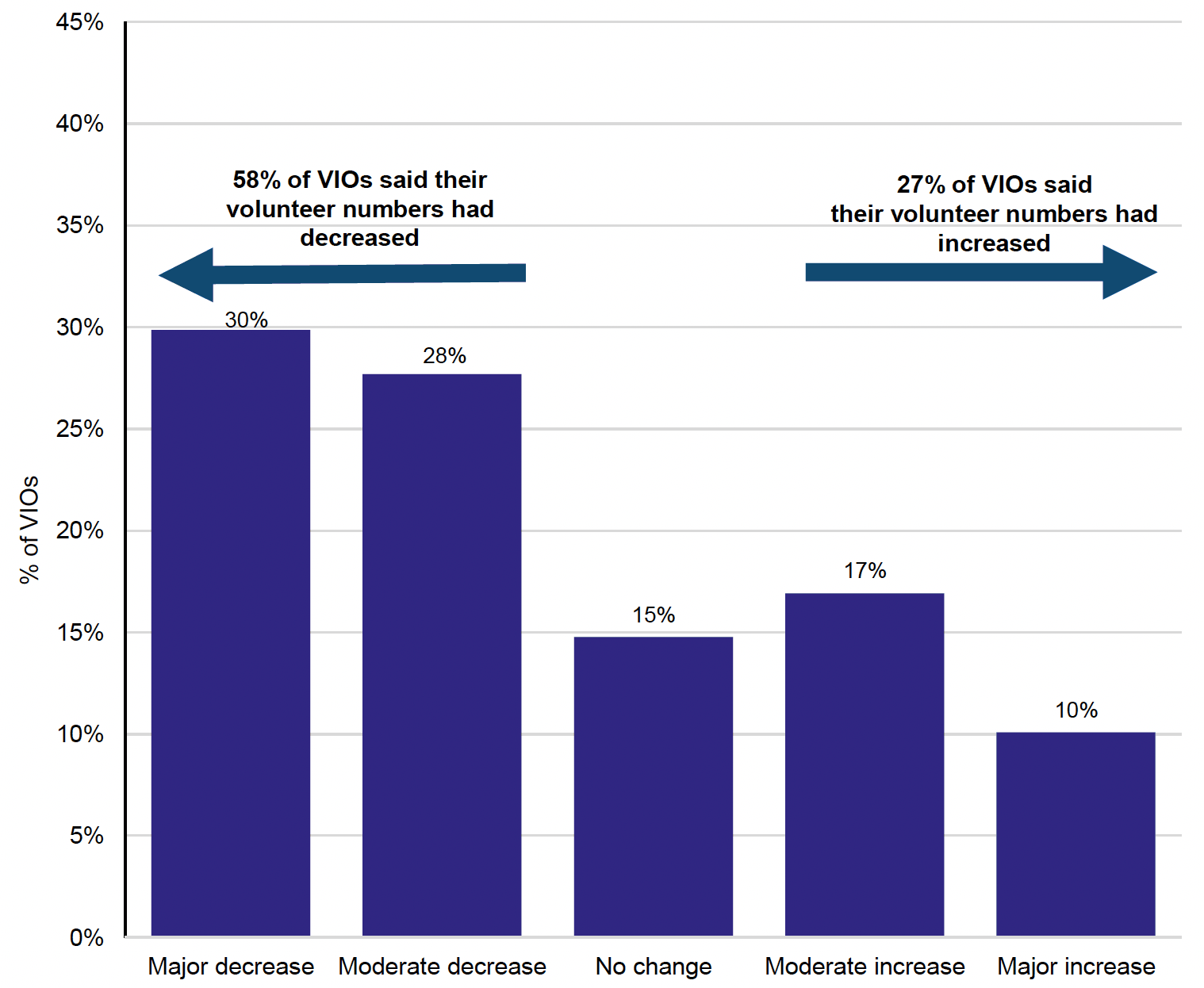
In response to the survey question on how their volunteer numbers had changed, at the point when they completed the survey (April-June 2021) 58% of responding volunteer-involving organisations said that their volunteer numbers had decreased since the beginning of the pandemic (March 2020) – with 30% saying that they had experienced a major decrease. A smaller proportion of VIOs (27%) indicated that their volunteer numbers had increased during the pandemic (Figure 3.1).
Enabling factors for organisations that said their volunteer numbers had increased during COVID-19 included:
- Their organisation was able to adapt their work quickly to enable remote delivery of services with volunteer support;
- Their organisation changed the focus of their work to respond directly to needs arising from the pandemic, and needed volunteer support to do this;
- Their organisation was able to provide outdoors volunteering opportunities.
'[We] introduced our Virtual Hospice in April 2020. In-person support that would have been provided to families through a visit to our hospices was transferred to a virtual model. Two volunteer roles were introduced as part of this which meant that volunteers could support families remotely from home.'
'Instead of our volunteers running manufacturing, retail and sales activities - they downed tools and made scrubs, masks and other PPE resources. A small number of volunteers set-up and/or ran foodbanks and food parcel delivery and collection services. We also ran a range of workshops and community support sessions for volunteers to keep people connected, give them meaningful volunteering experiences and continued skills development. Aside from all the COVID resilience work, volunteers also manufactured a small range of products for us to sell online and in the shop (between lockdowns) to ensure some continued trading income as we are a social enterprise and rely to trading income to supplement grant funding.'
'[Our organisation] was formed by local residents who had been taking care of the local environment during the first lockdown and teamed up for group litter picks during summer 2020. COVID has restricted the number of people who can meet up outdoors, so group activities were postponed during the winter lockdown. However, individuals have continued cleaning up their neighbourhood on their own.'
We undertook some additional analysis of this data by sector. Although no very strong patterns emerged according to sector, organisations placing volunteers in sectors that were particularly relevant during the pandemic – such as befriending, mental health and wellbeing, older people and employability – appeared somewhat more likely to have increased their volunteer numbers, and somewhat less likely to have experienced decreases. Organisations working on environmental issues or working with animals were also slightly more likely to have seen increased volunteer numbers – perhaps because many of their volunteers were able to volunteer outdoors where social distancing and safe volunteering would be easier to manage.
3.1.2 Infrastructure organisation views on changes in volunteer numbers
A majority of infrastructure organisations considered that volunteering of all types had increased during the first lockdown (March-June 2020). Infrastructure organisations were more likely to say that the numbers of volunteers undertaking informal and mutual aid volunteering had increased, with 87% of infrastructure organisations saying that there had been an increase in the numbers of informal volunteers and 81% saying that there had been an increase in the number of mutual aid volunteers.
In contrast with the responses of VIOs, 60% of infrastructure organisations considered that there had been an increase in the number of formal volunteers in their areas. Conversely, 33% of infrastructure organisations said that formal volunteering had decreased in their area during the first lockdown period, compared with pre-pandemic levels.
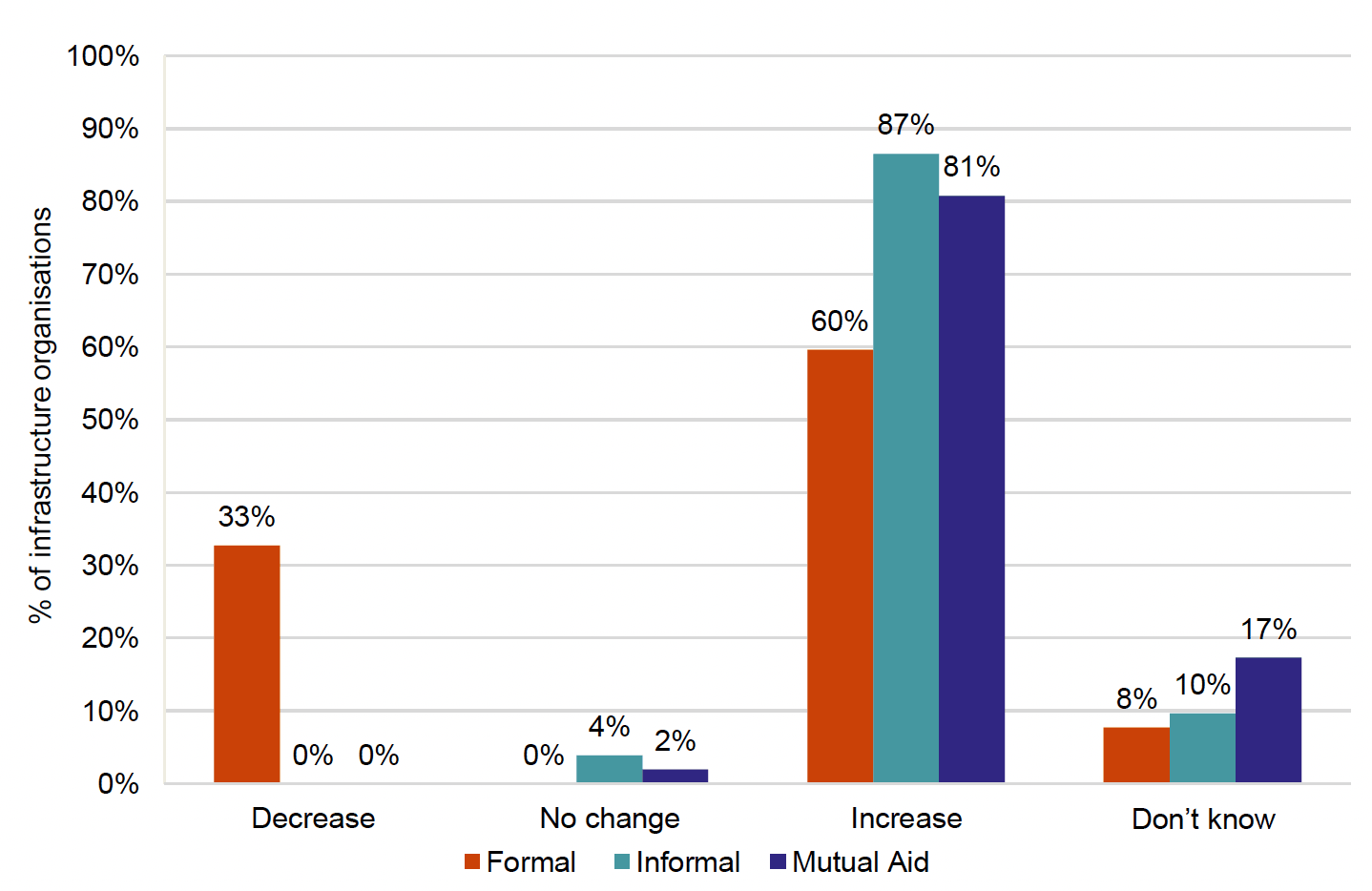
During the second lockdown (December 2020-March 2021), comparison with pre-pandemic volunteering levels still indicated significant increases across all types of volunteering, but to a lesser extent than in the first lockdown, suggesting that the initial surge in volunteering had reduced to some extent. As shown in Figure 3.3, 50% of infrastructure organisations said that there had been an increase in the numbers of formal volunteers during the second lockdown compared with before the pandemic, while the corresponding figures for informal volunteers and mutual aid were 52% and 52%.
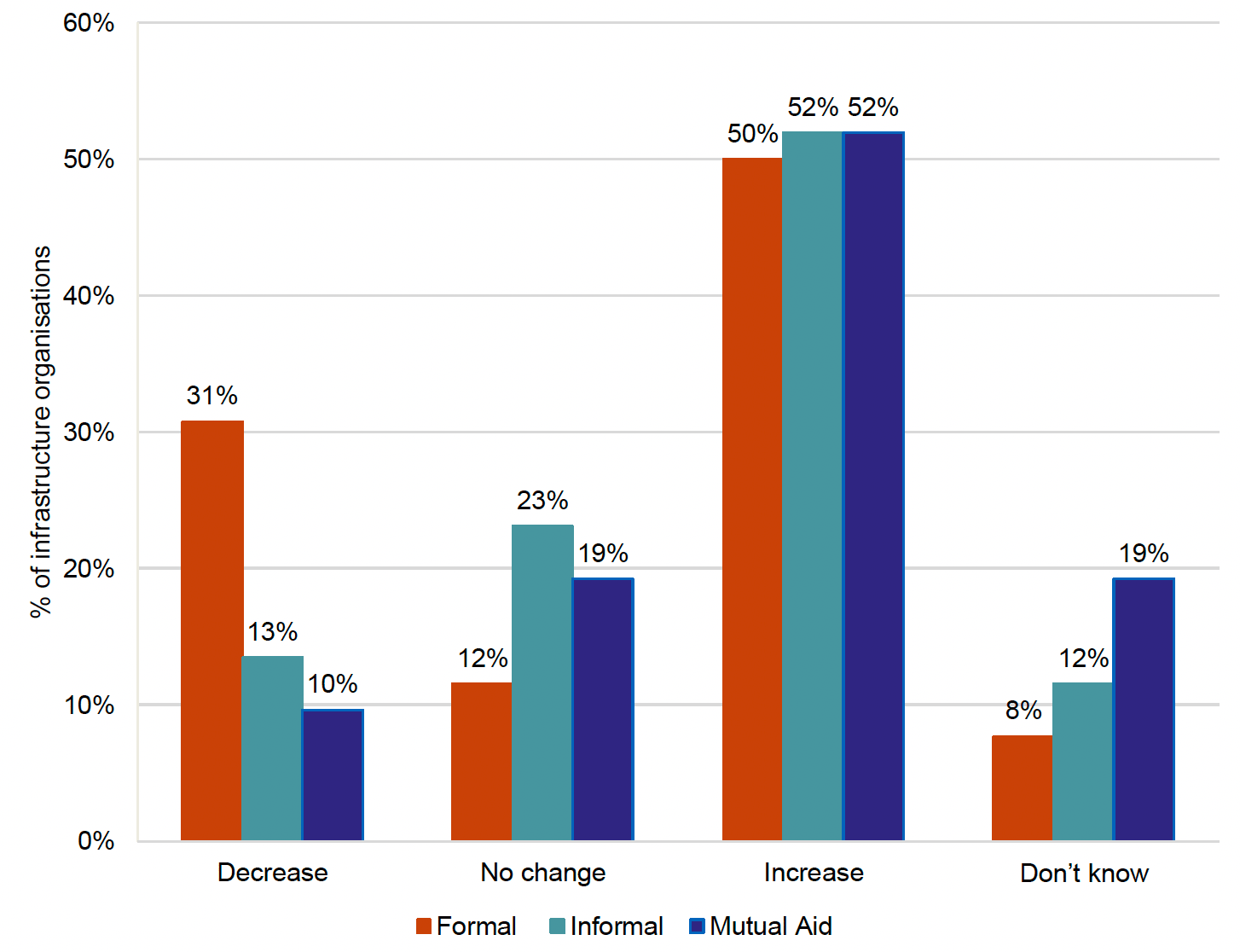
While a significant proportion of the responding infrastructure organisations considered that formal volunteering increased during the lockdowns, this did not reflect the experience reported by the volunteer-involving organisations that responded to the survey, who overwhelmingly said that their volunteer numbers had decreased.
There are a number of possible reasons for the differences between what volunteer-involving organisations and infrastructure organisations said. The volunteer-involving organisations responding to the survey were established organisations with pre-existing volunteer programmes, many of which could not be continued under the pandemic restrictions. Many of these organisations were not directly engaged in COVID response work, at least initially. In contrast, from their comments it is clear that infrastructure organisations were reflecting the growth in COVID-response volunteering with a subset of community-based organisations in their responses – for example, the growth of volunteering through community councils and resilience groups, where these took a lead in coordinating local COVID-19 responses; or, later on, the growth in volunteering for the COVID-19 vaccination programme. The survey responses also suggest that some infrastructure organisations conflated offers of volunteering and volunteer registrations – the thousands of people who signed up to be part of volunteering efforts – with the deployment of volunteers, which was much lower in practice.
While the survey questionnaire asked infrastructure organisations to distinguish between 'formal', 'informal' and 'mutual aid' volunteering in their responses, it is clear that these were not always easy distinctions to make in practice, and that respondents had different views of what they considered to be informal and formal volunteering. Some 'mutual aid' groups became linked with or absorbed into pre-existing formalised community structures as the pandemic progressed.
Finally, the term 'volunteering' was also used by local authorities to denote local authority staff offering to redeploy into pandemic support roles – for example within education hubs and care homes – and within the NHS to denote former health care professionals and students taking on roles in the NHS. This is reflected in some of the survey comments. Since these were paid staff, this is not 'volunteering' in the sense of being unpaid work.
3.1.3 Infrastructure organisations' views on changing patterns of volunteering
In Figure 3.4, infrastructure organisations share their views about ways in which volunteering patterns changed during the pandemic.
Particularly notable was the emergence of new voluntary or community groups during the first lockdown, with 65% of infrastructure organisations agreeing 'to a large extent' that new groups had become active in their areas. The rapid emergence of new community response initiatives and 'mutual aid' groups, which provided a platform for people to offer and receive support in their local communities, was a defining feature of the early phase of the pandemic. Infrastructure organisations also described how linkages quickly developed between 'pop-up' new mutual-aid type organisations and more established organisations such as community councils or resilience groups.
'A high number of Facebook and WhatsApp community based groups started up which [the local TSI] organised into local community response groups. This added significantly to the pool of local voluntary [capacity] available. In addition, a very large number of people living in [local authority area] registered to volunteer with the Ready Scotland portal. These were in addition to the community response groups and we have been able to find volunteering opportunities for about three-quarters of them.'
'We saw an increase in community response, which has meant some 'pop up' food banks or response services as well as an increase in the number of volunteers in established community organisations…
We have seen that in small communities local people have looked after each other – recognising the needs within different households and responding to these needs quickly and without judgement. We think this kind of volunteering will have reduced the need for some crisis support - reducing isolation and keeping vulnerable people safe.'
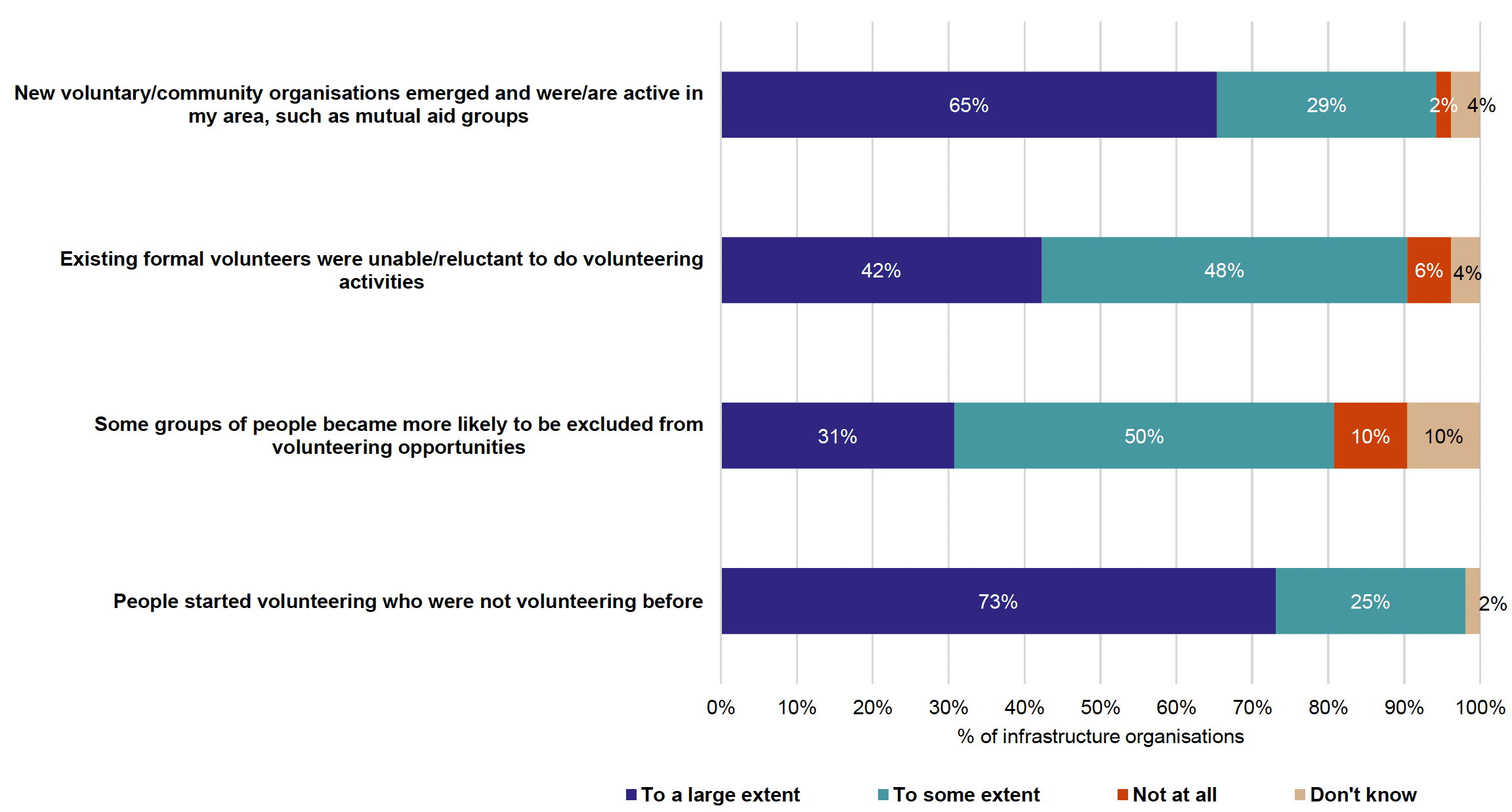
Seventy-three percent of infrastructure organisations agreed 'to a large extent' that people started volunteering at the beginning of the pandemic who had not been volunteering before. Respondents linked this increase in new volunteers to the fact that many working people and younger people had more time available than usual – either because they had lost their employment or because they had been furloughed. The lockdown conditions requiring people to remain in their local areas were also seen to have contributed to the increase in community-based volunteering. Finally, there was a recognition that people were volunteering to support others; to reduce their own experience of isolation and loneliness during the pandemic; and because the situation was so exceptional that many people felt particularly motivated to help in some way.
'We have seen an increase in people aged between 19-50… volunteering due to the fact they are either on furlough, or are unemployed and looking to offer their help. We have also seen an increase in requests from people who are working but are working from home and with no-where else to go are looking for activities to fill their time.'
'People who would not have previously considered volunteering were looking for an outlet which reduced isolation and loneliness and viewed volunteering as a means to improve mental health. …The lockdown led to an increase in the focus of local needs and generated a local response; where people may have volunteered outwith their own neighbourhood the lockdown to a large extent focused their time and attention on the needs of the local community.'
'We had an unprecedented number of people sign up to help in our local area. We called many of them and it would be fair to say that many had signed up because of the COVID situation/to respond to need rather than because of their own volunteering experience/previous interest in volunteering.'
'In [local authority area] we have seen a huge rise in individuals looking to formally volunteer as well as many new mutual aid groups forming to deal with the impact of COVID on our local communities. The range of expertise and skills has been unbelievable with many on furlough looking to continue to volunteer when they hopefully return to work. The pandemic has shown the reach volunteers have and the difference they make which has been greatly received in [local authority area].'
Several infrastructure organisations identified a pattern of large and rapid initial increases in volunteer registrations and activity during the first lockdown, followed by a drop off during the second lockdown in early 2021:
'We experienced a sharp increase in volunteering in the first lockdown as people came forward to volunteer in response to local needs and in response to the Ready Scotland and Red Cross appeals. We also experienced a sharp increase in support required for mutual aid and community organisations to support safer volunteering practices.
In the second lockdown, we did not experience the same spike in volunteer registrations as the community responses were already established although there was still an increase and offers to volunteer from those who had signed up during the first lockdown – however, many were back to work during the second lockdown which affected availability to volunteer.'
'As restrictions ease and organisations start to open up again it is clear that many volunteers from early 2020 are no longer available or able to continue volunteering and there is once more a great demand for volunteers.'
Organisations also emphasised the importance of finding ways to keep this new volunteer force engaged for the future:
There has been an incredible community response to the pandemic, supported through formal and informal groups and organisations…Over 1200 people from across [our local authority area] have signed up to volunteer during the crisis. …Individuals have secured opportunities with a range of third sector partners ... Individuals have been helping with food parcel deliveries to those in need, PPE supplies to carers, medicine pick-ups and support as ward helpers …. It is hoped that individuals will be able to secure long-term volunteering opportunities post Covid-19. One particularly positive (and unexpected) outcome has been the number of individuals expressing interest in volunteering as trustees.'
At the same time as this growth in new volunteers and new organisations, many existing volunteers had to withdraw from their volunteering activities because of the advice to remain at home or shield. This was particularly the case for pre-existing older volunteers, and volunteers with underlying health conditions or other vulnerabilities. Forty-two percent of infrastructure organisations agreed that pre-existing volunteers were unable or reluctant to volunteer 'to a large extent', with a further 48% agreeing 'to some extent'.
Similarly, 31% of infrastructure organisations expressed concern that some groups had become more likely to be excluded from volunteering during the pandemic, 'to a large extent'. According to respondents, the groups at higher risk of exclusion from volunteering during the pandemic were older people, people with health conditions, and people requiring support to volunteer – particularly people with learning difficulties, disabilities, or mental health conditions. To a lesser extent, respondents also mentioned people with caring responsibilities as having had to withdraw from volunteering in order to reduce potential risk of COVID-19 exposure to those they care for, as well as parents who were having to remain at home to look after children.
'We have a large number of older volunteers …who were unable to volunteer due to COVID advice. …Older people who volunteered prior to lockdown were deeply affected by this as they were often socially excluded and experienced isolation and loneliness due to the social interaction been removed. We heard the comment 'if i ever get back' a lot from this age group while in contact with them, as the lockdown wore on especially during the second lockdown, when it looked uncertain how long lockdown would last.
'Volunteers with additional support needs have been disproportionally disadvantaged in the pandemic. While volunteers with few barriers were able to volunteer in other capacities, mutual aid etc. if their formal volunteering has stopped, for those with support needs this was not possible. Many will have had to shield and other will simply have had support needs that could not be properly addressed in the volunteering available during the pandemic. As we emerge from the second lockdown we are seeing that volunteers with higher support needs are returning much more slowly or their previous roles have disappeared and often organisations are under such pressure that they are unable at this time to take on volunteers with support needs.'
3.2 Volunteer tasks
We asked the survey respondents about the kinds of volunteering tasks for which demand was highest during the pandemic. The results reflect the differing perspectives of infrastructure organisations – with their broad overview of the range of organisations and volunteers that were active in their local areas – and volunteer-involving organisations, which were asked to focus on the questions from the perspective of their own organisation's work.
Infrastructure organisations (Figure 3.5) had a broad overview of the different types of volunteering that were undertaken within their local areas during the pandemic – including formal, informal and mutual aid volunteering. Their responses reflect this broad range of organisations and tasks. They found that during the first lock-down, food-related support tasks were the most frequently needed – 79% of respondents highlighted food support including food banks and delivering food parcels or hot meals, while 75% said that food shopping was a key task. Collecting and delivering prescriptions was the next most high-demand task, as indicated by 71% of respondents. Befriending (63%) and other forms of support for people with physical and mental health problems (40%) were the fourth and fifth highest-demand activities, respectively.
In the second lockdown, according to infrastructure organisations, the needs for volunteer support shifted significantly away from food support, food shopping and deliveries, perhaps reflecting that many people had been able to put other solutions in place to meet their needs by this point. Changes such as the introduction of the extended household policy; supermarkets putting increased capacity for deliveries in place, and increased formal food support availability also probably reduced the need for some of these types of volunteering support. However, the demand for befriending remained high (as indicated by 62% of respondents), and there was an increase in demand for volunteers to support people with mental or physical health problems (50%). Volunteering to support the COVID-19 vaccination programme also emerged as a high-demand task during the second lockdown (29%), after the vaccine roll-out got underway in January 2021.
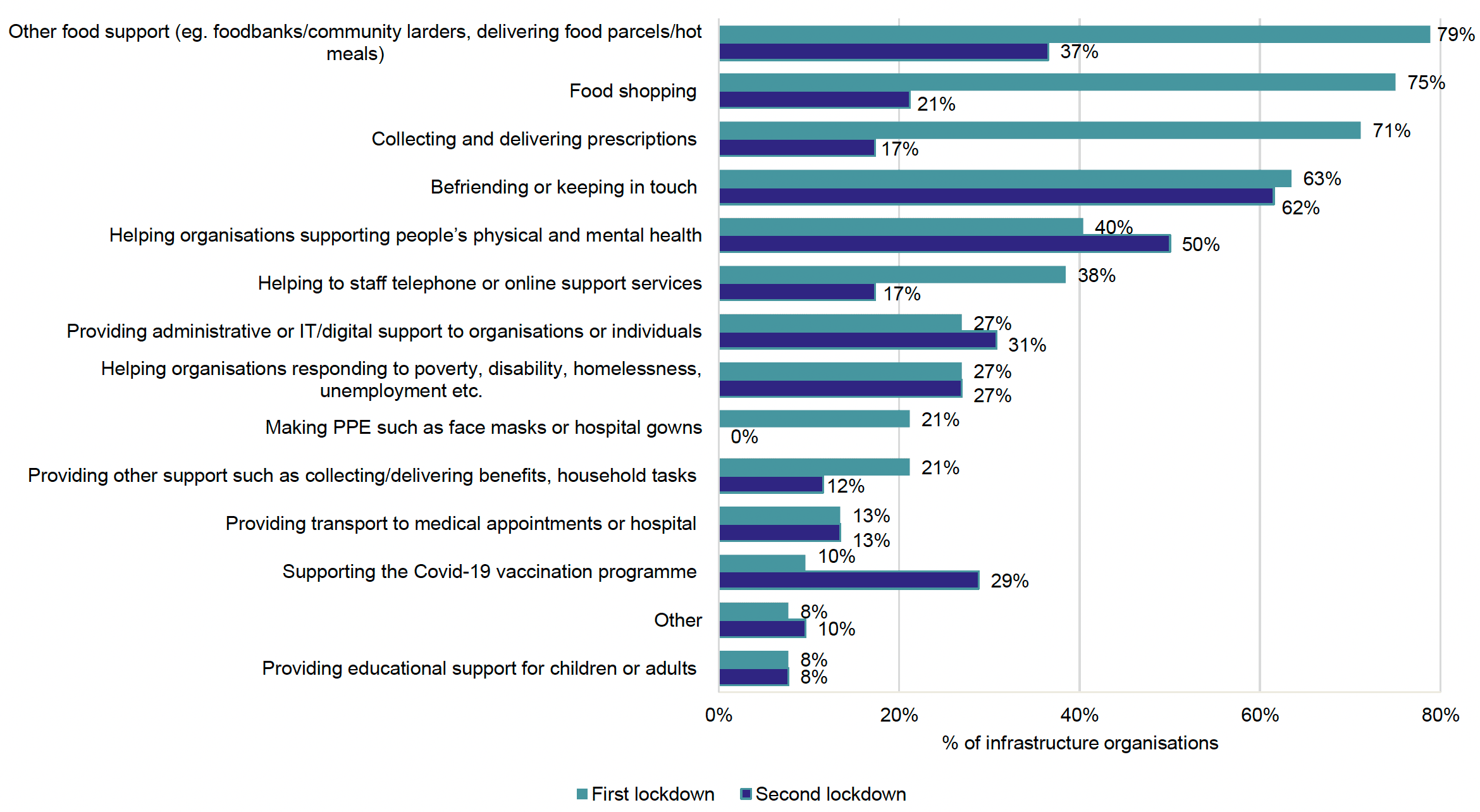
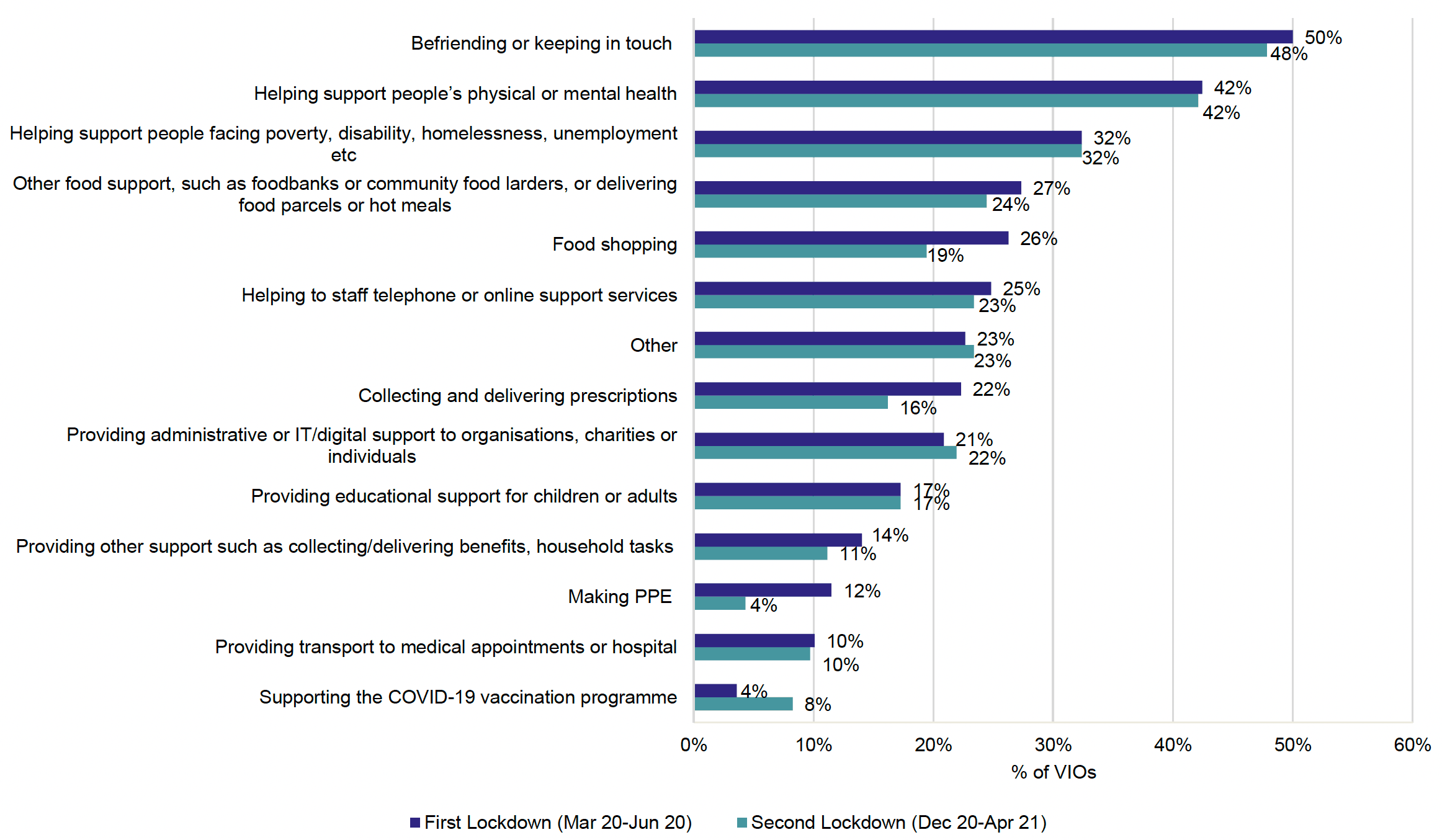
VIOs were asked what tasks their volunteers had undertaken during the first and second lockdowns (Figure 3.6). Befriending was the most frequently mentioned volunteering task with 50% of VIOs saying that their volunteers did this during the first lockdown, and 48% during the second. Support for people with mental or physical health problems was the next most-frequently mentioned volunteer task, as indicated by 42% of VIOs for both lockdowns.
The tasks that VIOs said their volunteers undertook were quite similar during both lockdowns. Differences were reflected in reductions in food shopping and in making PPE – which were more important during the first than the second lockdown – and in volunteering to support the vaccination programme, which began later in the pandemic.
Differences between what the VIOs and the infrastructure organisations reported about volunteer tasks may reflect the focus of the VIOs that responded to the survey. Many of the responding organisations were involved in mental health and wellbeing, befriending and work with older people, and the work their volunteers undertook during the pandemic reflected these core purposes. In contrast, infrastructure organisations were also reflecting the work of the mutual aid and informal volunteers in their response, much of which was put in place to provide support in local communities with shopping, deliveries, and transport.
This informal emergency support response appeared to have been more needed during the first than the second COVID lockdown, in part because by the time of the second lockdown, institutional partners had been able to build up greater preparedness around food and other essential supplies. Infrastructure organisation respondents described how there was a shift away from the rapid emergence of mutual aid and informal support responses during the first lockdown towards greater institutional preparedness during the second:
'Communities mobilised very quickly to respond to the COVID outbreak and lockdown and were essential in helping to identify and support vulnerable people, particularly when shops were running out of food. We worked proactively with local anchor organisations to provide support. As lockdown eased and supply chains were re-established, the need for this type of activity reduced significantly. [Local authority] built the resilience and capacity of community food networks and its own food stores in preparation for lockdown 2 and winter with the result that people were provided appropriate support without significant involvement of food groups. There is now an emphasis on the vaccination programme and dealing with the ongoing impact of lockdown and COVID, particularly in relation to mental wellbeing, lost learning and employability.'
'During the first lockdown and early part of the pandemic there was very much an 'emergency response' from individuals, communities and organisations with people just trying to organise themselves to act as quickly as possible to help and protect those in need and vulnerable, and the demand in the first lockdown was around getting basic supplies and supports to people and to preserve life and reduce harm.
As things progressed beyond the initial few weeks there was greater consideration given to joint planning, making best use of volunteer resource and ensuring volunteers themselves were protected and able to work as safely as possible. This meant that by the end of first full lockdown and into second lockdown certain services and activities were better organised across the voluntary and public sector and less 'reactive' and with clearer support processes and procedures in place for individuals and organisations the demand balanced out.
As the impact of the pandemic continued throughout first and second lockdown and as the initial basic needs were largely being met it was apparent that services like mental health and wellbeing and longer term work to support people out of poverty and inequality was required (loss of jobs, confidence, digital inclusion, depression) and volunteering activity increasingly adapted to reflect this need.'
Contact
Email: socialresearch@gov.scot
There is a problem
Thanks for your feedback